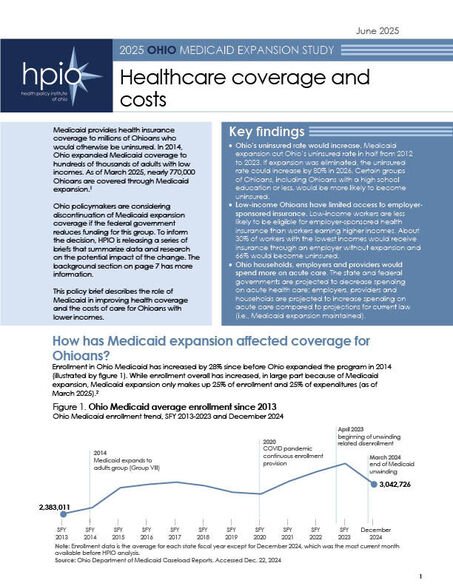2025 OHIO MEDICAID EXPANSION STUDY
Healthcare coverage and costs

Healthcare coverage and costs
Medicaid provides health insurance coverage to millions of Ohioans who would otherwise be uninsured. In 2014, Ohio expanded Medicaid coverage to hundreds of thousands of adults with low incomes – including people who are working or veterans and parents, grandparents and other caregivers. As of March 2025, nearly 770,000 Ohioans are covered through Medicaid expansion.
Ohio policymakers are considering discontinuation of Medicaid expansion coverage if the federal government reduces funding for this group. To inform the decision, HPIO is releasing a series of briefs that summarize data and research on the potential impact of the change.
This policy brief describes the role of Medicaid in improving health coverage and the costs of care for Ohioans with lower incomes.
3 Key Findings for Policymakers
- Ohio’s uninsured rate would increase. Medicaid expansion cut Ohio’s uninsured rate in half from 2012 to 2023. If expansion was eliminated, the uninsured rate could increase by 80% in 2026. Certain groups of Ohioans, including Ohioans with a high school education or less, would be more likely to become uninsured.
- Low-income Ohioans have limited access to employer-sponsored insurance. Low-income workers are less likely to be eligible for employer-sponsored health insurance than workers earning higher incomes. About 30% of workers with the lowest incomes would receive insurance through an employer without expansion and 66% would become uninsured.
- Ohio households, employers and providers would spend more on acute care. The state and federal governments are projected to decrease spending on acute health care; employers, providers and households are projected to increase spending on acute care compared to projections for current law (i.e., Medicaid expansion maintained).
About HPIO's 2025 Ohio Medicaid Expansion Study
HPIO has launched an expansive study on the potential impacts of the elimination of Medicaid expansion in Ohio.
Since Ohio expanded Medicaid eligibility in 2014, hundreds of thousands of residents with lower incomes – including people who are working, parents, grandparents, veterans and caregivers – have gained access to medically necessary health care. As of March 2025, nearly 770,000 Ohioans are covered through Medicaid expansion.
The federal Affordable Care Act (ACA) and a subsequent U.S. Supreme Court decision permitted states to expand Medicaid eligibility to adults earning less than 138% of the federal poverty level (FPL). The federal government pays 90% of the cost of the Medicaid expansion group and the state government pays 10%. The proposed 2026-2027 biennial state budget (House Bill 96) would discontinue Medicaid expansion if the enhanced FMAP for Medicaid expansion drops below 90%.
Resources
- More information about the study and links to additional briefs can be found on the 2025 Ohio Medicaid Expansion Study page.
- Eliminating Medicaid Expansion in Ohio in Response to Reduced Federal Funding, prepared for HPIO by the Urban Institute
- HPIO’s Policy Considerations: The Future of Group VIII (expansion) Medicaid Coverage in Ohio brief contains more general information and considerations about Medicaid expansion coverage as policymakers consider the future of the program.
- Ohio Medicaid Basics 2025 provides an overview of the Ohio Medicaid program, including eligibility, covered services, spending and recent policy changes.
- 4-page summary of all five briefs in this series
Facts and Figures
Use HPIO graphics and data in your work (presentations, social media posts, etc.). To use the data graphics in your presentations, click here to access the slides on Google Drive, click “File” and then “Download.” This will allow the option to download individual slides or the full deck into PowerPoint slides, a jpg, pdf or other available media files.
For graphics and slides from ALL phases of the study, see the 2025 Medicaid Expansion Study project page.
Funders
This study was made possible by support from the bi3 Fund, Interact for Health, Mt. Sinai Health Foundation, The George Gund Foundation, the Harmony Project, The Columbus Foundation and HPIO’s other core funders.
By:
Amy Rohling McGee, MSW
Jacob Santiago, MSW
Published On
June 4, 2025
 Download Publication
Download Publication
